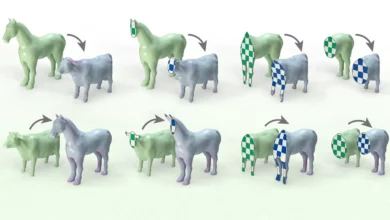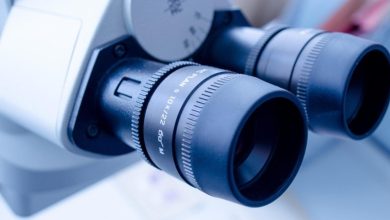
You must have seen Princess Leia as a floating image in Star Wars or the gesture-controlled three-dimensional models in the Iron Man films, those intriguing, moving 3D images are called holograms. Some experts define holograms as two-dimensional surfaces capable of manifesting information in three dimensions. In movies, holograms are an illusion created using VFX and animation, but in reality, they can be generated using a technique called holography.
Holograms have featured in numerous video games and sci-fi movies and since holography is a complicated technique (when it comes to creating 3D holograms), for years, it was believed that holograms would remain limited to the world of science fiction only. However, thanks to advancements in optical holography, seems like now the gap between fiction and reality is narrowing, and we are much close to seeing 3D holograms in real life as well.
Different types of Holograms

Holograms are virtual, three-dimensional images produced by the interference of light beams that reflect real physical objects. In simple words, holograms are 3D images formed when two light beams interfere and produce an image on a film or other surfaces. While there are many types of holograms and varying ways to classify them, most holograms are variations or hybrids of either reflection holograms or transmission holograms.
Reflection hologram
Holograms commonly found in art galleries are an excellent example of a reflection hologram. Such a hologram can be viewed when the observer is standing alongside the light source, and it is best viewed under white light. A 3D image is seen on a surface, the light source is located at the front, and the resultant virtual image is formed at the back of the film’s surface.
The colored version of the reflection hologram can be so perfect that you might find it hard to distinguish between the original object and its holographic image.
Transmission holograms
Here, the light source is placed behind the hologram, the image is transmitted to the viewer’s side, and the image thus produced is very sharp and has more depth. They are viewed with the help of laser light and interestingly. Suppose you created a transmission hologram of an object or an environment and then broke the same into multiple small holograms. Interestingly, each tiny piece of the broken hologram would still be able to project the complete imagery of the original object.
The eagle on a VISA card, which uses a layer of aluminum on the back for the mirror effect, is also an example of transmission holograms.
Hybrid holograms
Other than reflection and transmission holograms, there are numerous other sub-types that behave as hybrid versions of the above two, and all these holograms are called hybrid holograms. The embossed and rainbow holograms found on credit cards, computer-generated holograms used to create holographic optical elements, Denisyuk holograms, multichannel holograms, real-time holographic interferometry, etc. are all examples of hybrid holograms.
The science behind holograms
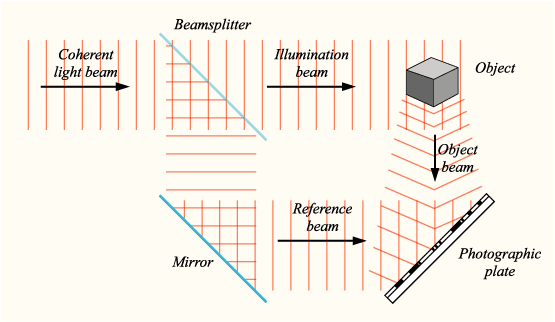
To understand the workings of a hologram, first, you need to understand how a camera captures a photograph. The shutter opens and light bouncing off the surface of objects passes through the lens and hits photographic emulsion on the film or, for digital cameras, the charged coupled device (CCD), a chip that converts light into electrical signals and turns the light falling into a digital image. A light-sensitive compound on the film, silver halide reacts with the light and records its amplitude or intensity.
The image we see is actually the recorded intensity of the light (here, light intensity is the rate at which light spreads off the surface of an object of a given area and over a certain distance from the source of light).
In the case of a hologram, the working principle is nearly the same but the setup is different. Here, you have a laser beam pointed towards a plate that splits a coherent laser into two beams, the reference beam, and the illumination beam. Again, a shutter opens or moves out of the path of the laser. The light from the reference beam is directly sent to the photographic plate, and the illumination beam is reflected off the object’s surface before it hits the photographic plate.
Later, in order to recreate the image, the photographic plate is lit up by a light source, similar to the one used before. The hologram records a pattern of tiny bands of light called interference fringes. Turning these microscopic interference fringes into a recognizable image requires the right kind of light. Through a complex process, the light source converts the interference fringes into a reflection identical to the original object.
History and development
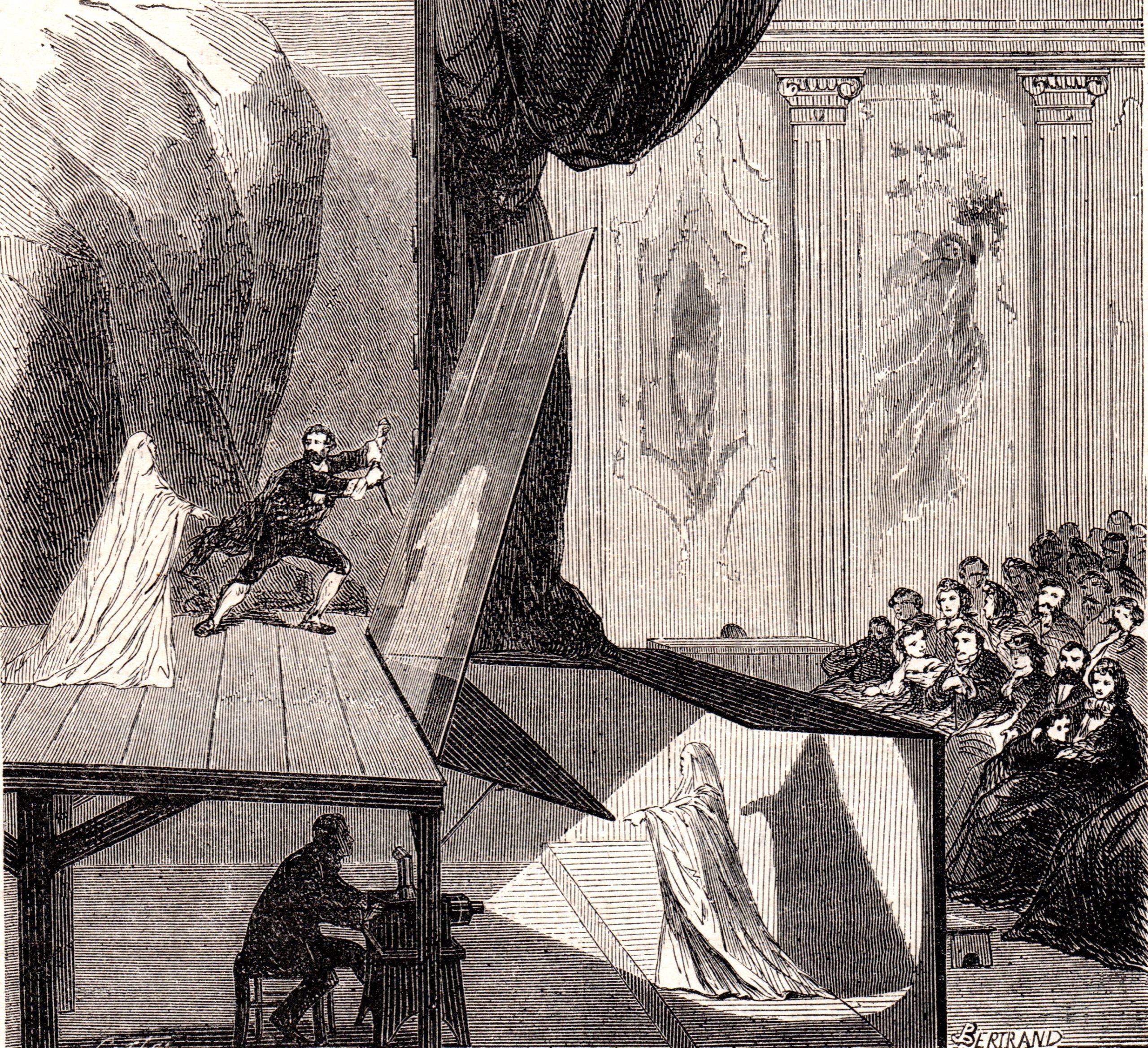
In 1860, nearly a century before the development of modern holography. An English scientist named John Henry Pepper displayed a type of holographic element called the Pepper’s Ghost in a play, using mirrors and light. It was an illusionary trick that used the reflective property of glass to project an image of a person or objects into the air from a hidden location away from the audience’s eyes. Because of the weak light used, such as oil lamps and candles, the images that appeared were very transparent – leading to the name Pepper’s Ghost.
However, Pepper’s Ghost was an illusion, not a real hologram, and it wasn’t until 1947, a Hungarian-born scientist Dennis Gabor, developed the theory of holography while experimenting with ways to improve the resolving power of the electron microscope. Gabor was looking for a solution to enhance the low resolving power of the existing microscopes, as they weren’t powerful enough to reveal atomic details to the extent he wanted.
While playing tennis on Easter Sunday in 1947, Gabor came up with the solution for his problem. He devised a two-stage process (which later became holography’s core principle). In the first stage, he divided a coherent light beam into an object beam and a reference beam. Then he recorded the interference pattern made by the beams on a photographic plate.
In the second stage, the reconstruction. He lit the hologram with visible light to obtain an image, Gabor called this so-formed interference pattern a hologram.
However, originally Gabor’s system used the light from the electron beam and recorded the interference between the light diffracted by the object and a collinear background. This restricted the process to objects that were largely transparent. When the hologram is used to form an image, twin images are formed, but because the light associated with these images is propagating in the same direction, one image appears out-of-focus.
This original technique reduced the light intensity too much for it to produce real holographic images and so Gabor’s idea remained theoretical. This changed with the development of lasers in the 1960s.
The formation of a perfect hologram requires a coherent light source such as a laser. So most of the light sources used before the invention of the laser (which had a mix of multiple colors) resulted in dimmer and hazy holograms, and this led to scientists losing interest in the development of real holograms until the 1960s, when scientists Nikolay Basoy, Charles Towns, and Alexander Prokhorov invented laser light. The pure monochromatic, single-color and intense laser light rays were ideal for use in holography.
In 1962, a group of researchers created a device using a continuous wave laser that could record 3D objects. However, the device wasn’t perfect for creating holograms but it did introduce a new way to use refractive index for the purpose of light ray transmission and kick off a slew of experiments and studies directed towards the development of real holograms.
Applications of holography
Here is how holograms can benefit humanity in various ways:
- Holograms can help police and armed forces to perform their operations more securely and efficiently in crowded areas. In 2017 Defense Advanced Research Projects Agency (DARPA) developed a 3D holographic map that could provide a real-time, 360-degree map of an area. Using the map, an operation team could zoom in, rotate, see the buildings, roads, and analyze the situation in an area before making their move. Such technology could also give law enforcement forces the ability to avoid dangerous routes, helping them navigate the battlefield with safety and reducing friendly soldier casualties.
- Holograms technology could also change the way we communicate with each other, and some experts believe that it has the potential to replace video calling with live hologram calls. A Los Angeles-based technology company PORTL has claimed to develop a system that allows users from different locations to appear to be standing in the same room. To make this possible, the company uses its special booths equipped with computerized portals capable of creating life-size holograms of people who connect using their system.
- 3D holograms could make the learning process more interactive and accessible for both students and teachers, for example, students in remote areas or those without access to costly lab equipment could use holograms to provide advanced education to their students without buying the expensive equipment. 3D and detailed holograms can also benefit students who pursue architecture, design, and medical science. They can serve as a solution for students to apply textbook knowledge to the “real” world and gain practical experience.
- In 2017, scientists from Munich University developed a technique for obtaining 3D holograms using a Wi-Fi transmitter. This method could be used for creating holographic images of terrain, buildings, and structures, and in automated industrial facilities to track objects as they move through production. During natural calamities (such as landslides, earthquakes, etc.) the hologram can act as an excellent resource for helping search and rescue professionals. It could allow them to virtually navigate around collapsed buildings or avalanches and save hundreds and thousands of stranded individuals.
- Many medical diagnostic techniques such as Magnetic Resonance Imaging (MRI) and ultrasound scans display a flat image on a computer screen. These flat images provide a limited perspective but using holography doctors could have access to full color, computer-generated 3D holographic images, giving them detailed medical imagery of what’s going inside their patient’s body. Moreover, holograms could also allow medical professionals to extend their reach to remote areas and communicate effectively with their patients.
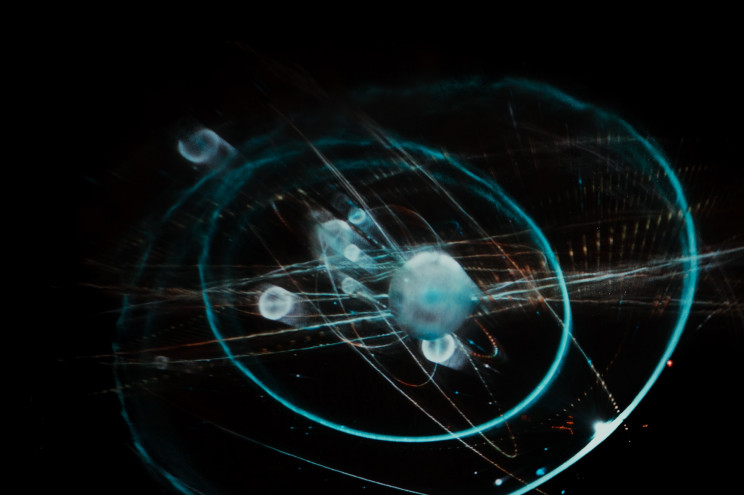
Every once in a while, researchers working in different parts of the world are coming up with some exciting developments related to hologram technology. These new findings also reveal numerous other hologram applications in fields such as marketing, advertisement, banking, gaming, and various other sectors. Although these uses of holograms have not yet become mainstream, all these developments strongly indicate that sooner or later, they will be used in a much wider variety of areas.

